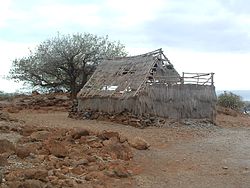Lapakahi State Historical Park

Lapakahi Complex | |
 | |
| Nearest city | Hawi, Hawaii |
|---|---|
| Coordinates | 20°10′31″N 155°53′50″W / 20.17528°N 155.89722°W |
| Area | 2,560 acres (1,040 ha) |
| Architectural style | Ancient Hawaiian |
| NRHP reference No. | 73000654[1] |
| Added to NRHP | July 2, 1973[1] |
Lapakahi State Historical Park is a large area of ruins from an Ancient Hawaiian fishing village in the North Kohala District on the Big Island of Hawaiʻi.[2][3] Offshore is the Lapakahi Marine Life Conservation District.
The name lapa kahi means "single ridge" in the Hawaiian Language, and applied to the ahupuaʻa, an ancient land division that ran from the sea up to Kohala Mountain.[4] It is located off of ʻAkoni Pule Highway (Route 270), 12.4 miles (20.0 km) north of Kawaihae, Hawaii.[5] It is state archaeological site 10-02-2245,[6] and was added to the National Register of Historic Places on July 2, 1973, as site 73000654.[1] Just to the north, Māhukona Beach Park is on a bay where raw sugar from a local sugar mill was shipped to San Francisco.[7]
References
[edit]- ^ a b c "National Register Information System". National Register of Historic Places. National Park Service. July 9, 2010.
- ^ Lapakahi State Historical Park brochure on Hawaiʻi State Park web site
- ^ Archaeological Inventory Survey for a Road Realignment in Kohala T.S. Dye, January 2008
- ^ Lloyd J. Soehren (2010). "lookup of lapakahi ". in Hawaiian Place Names. Ulukau, the Hawaiian Electronic Library. Retrieved October 30, 2010.
- ^ "Lapakahi State Historical Park". official Hawaii's State Park web site. Hawai'i Department of Land and Natural Resources. Retrieved November 4, 2018.
- ^ Historic sites in Hawaiʻi County on state web site
- ^ "North Kohala map". Shoreline access. on official Hawaiʻi County web site. Archived from the original on July 8, 2011. Retrieved July 27, 2010.
